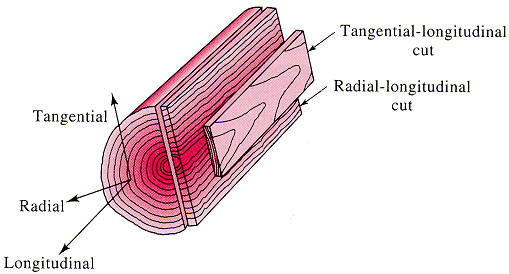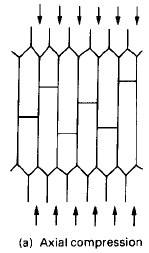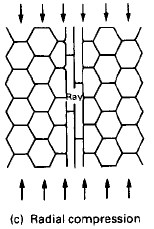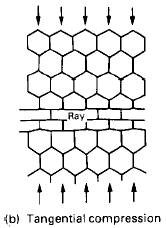Managed
tree plantations (genetic engineering, thinning, protein and
fertilization) has resulted in greater proportions of earlywood.
Difference in moduli found to be as high as seven.
--
"Mesostructure Elastic Properties in Loblolly Pine" by S. Cramer
| Material | Density (Mg/m3) |
Modulus (GPa) |
Tensile Strength (MPa) |
| Wood | 0.1-1 | 0.2-20 | 25-100 |
| Polymer | 1-2 | 0.01-10 | 5-100 |
| Ceramic | 1-5 | 10-1000 | 1-800 |
| Metal | 2-10 | 50-200 | 50-2000 |
| Material | Specific Strength (x105 psi) |
Specific Modulus (x107 psi) |
| Clear wood | 7 | 9.5 |
| Aluminum | 5 | 10.5 |
| 1020 steel | 2 | 10.5 |
| Copper | 1.5 | 5.5 |
| Concrete | 0.6 | 3.5 |
E varies a lot between wood types and between individual samples within the same type, due to variations in grain pattern and knot size and quantity.
| Wood | Density (for 12% water) (g/cm3) |
Modulus of Elasticity (psi) |
| Cedar | 0.32 | 1,100,000 |
| Pine | 0.35 | 1,200,000 |
| Fir | 0.48 | 2,000,000 |
| Maple | 0.48 | 1,500,000 |
| Birch | 0.62 | 2,000,000 |
| Oak | 0.68 | 1,800,000 |
Strengths also vary greatly. Note the anisotropic behavior of the following wood types classified by grain pattern and load type.

| Wood | Tensile Strength Longitudinal (psi) |
Tensile Strength Radial (psi) |
Compressive Strength Longitudinal (psi) |
Compressive Strength Radial (psi) |
 from The Science and Technology of Civil Engineering Materials, J.F. Young, et al., Prentice Hall, 1998. |
|
| Beech | 12,500 | 1,010 | 7,300 | 1,010 | ||
| Elm | 17,500 | 660 | 5,520 | 690 | ||
| Maple | 15,700 | 1,100 | 7,830 | 1,470 | ||
| Oak | 11,300 | 940 | 6,200 | 810 | ||
| Cedar | 6,600 | 320 | 6,020 | 920 | ||
| Fir | 11,300 | 390 | 5,460 | 610 | ||
| Pine | 10,600 | 310 | 4,800 | 440 | ||
| Spruce | 8,600 | 370 | 5,610 | 580 |
 |
 |
 |
from Engineering Materials 2, M.F. Ashby, R.H. Jones, Pergamon Press, 1986, p. 260. |
In summary, the mechanical properties of wood relate directly to the shape and size of its cells, and to the properties of the composite-like cell walls. Loaded along the grain, the cell walls are loaded in simple tension or compression, and the properties scale as the density. But across the grain, the cell walls bend, and then the properties depend on a power (3/2 to 2) of the density. That, plus the considerable anisotropy of the cell wall material, explain the enormous difference between the modulus, strength and toughness along the grain and across it. from Engineering Materials 2: An Introduction to Microstructures, Processing and Design, M.F. Ashby & D.R.H. Jones, Pergamon, 1994, p. 263.